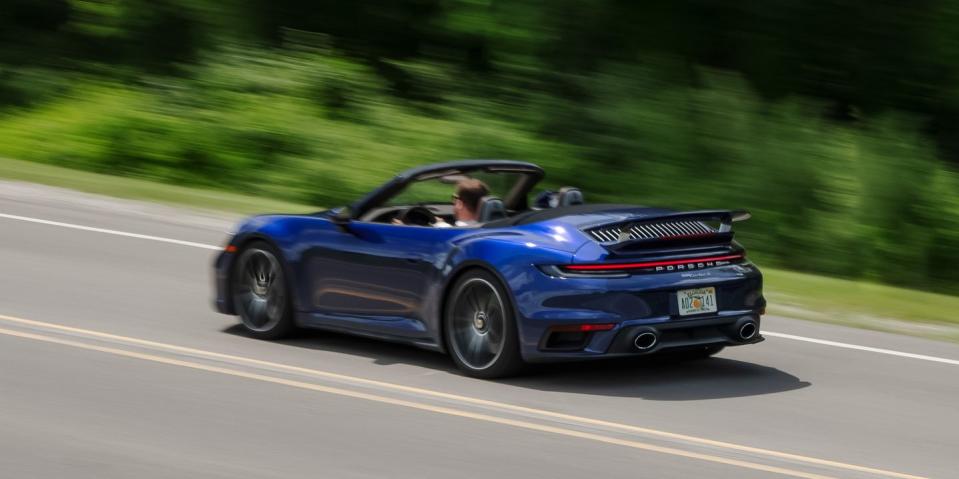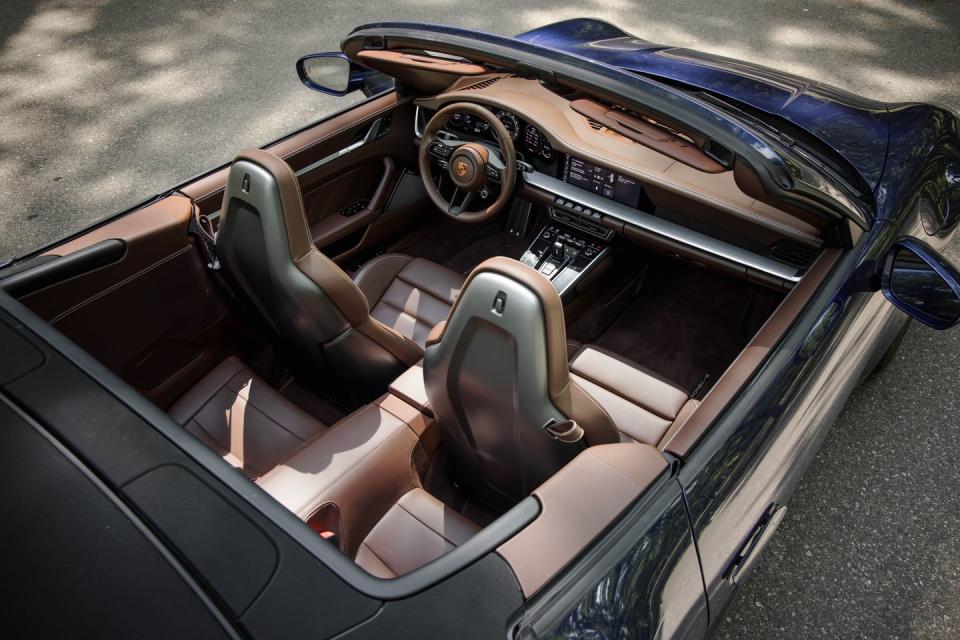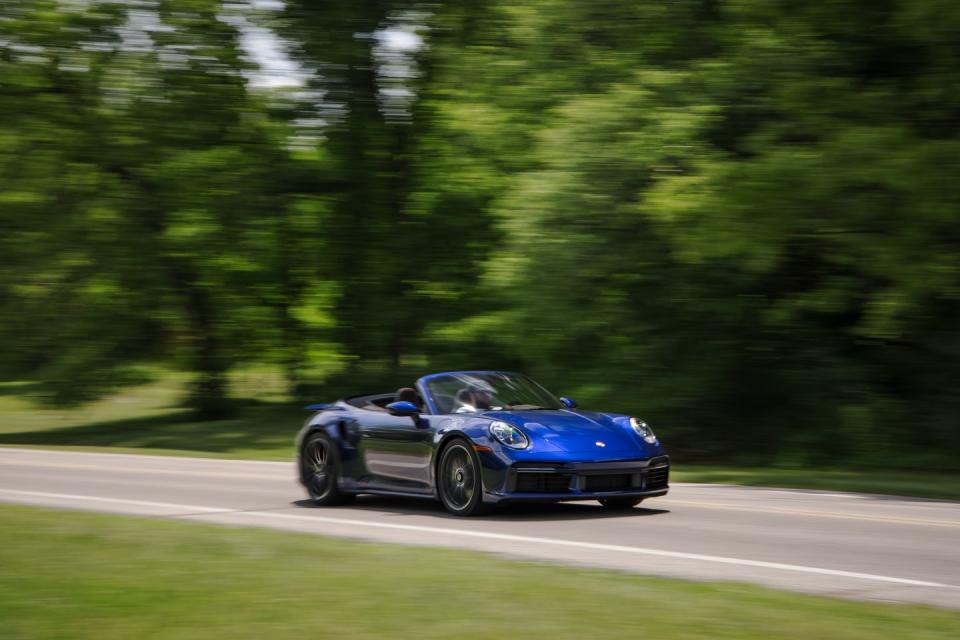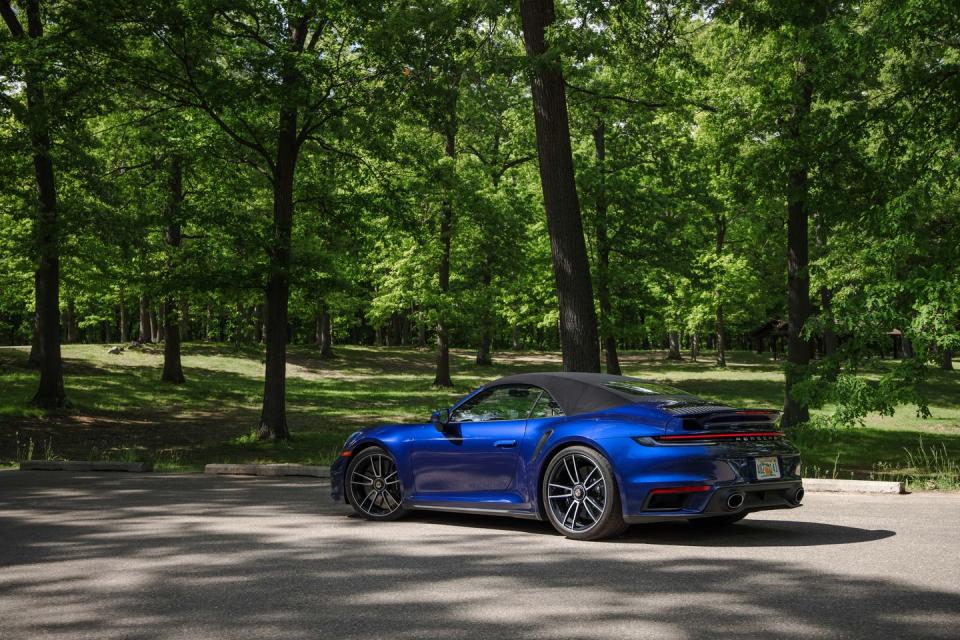Tested: 2021 Porsche 911 Turbo S Cabriolet Goes Ballistic

UPDATE 6/30/21: This review has been updated with test results.
For a moment, put aside thoughts of speed, adhesion, and power. Don't think about heritage, beauty, or price. Before we get to that, we'd like you to consider how tremendously good the 2021 Porsche 911 Turbo S is when it's going slow. Whether its urban trawling, suburban errands, or a lackadaisical back-roads tour, this is the best really fast car there is when velocities sink to a crawl.
When tasked with slowness, Lamborghinis and Ferraris champ at the bit, making their discontent with your pace known by barks, cackles, and fire breathing. Corvettes can fake easygoing pretty well, especially if you're a fan of the interior design and forgiving of fit and finish. And then there's the 911 Turbo S cabriolet, a $218,650 rocket that's utterly placid in the right lane. And the interior is attractive and crafted with care down to the last stitch on the leather-wrapped instrument panel.

Of course, with 640 horsepower on tap from its twin-turbocharged 3.7-liter flat-six, the 911 Turbo S cabriolet is always ready for you to call a blitz. This Porsche will propel itself to 60 mph in a mind-warping 2.3 seconds—one of the quickest times we've ever recorded—and it won't stop until it hits a claimed 205 mph, presumably with the top up. But most of the time, for most drivers, what matters is that this is a car that does low-speed better than all other high-speed cars, and that's what makes for a great and useable daily driver.
Porsche introduced the capital-letter 911 Turbo model way back in 1975. But it wasn't until the 1980s that the company added Targa and cabriolet variants. The part-roof and drop-roof models were rare, although the Turbo's wider body with massively suggestive fender flares looked particularly mean on the open-top models. Porsche's reason for developing the 911 Turbo was to homologate a turbocharged version of the 911 to go racing. And convertibles aren't for racing. So, there's been a certain tension within the mission of a 911 Turbo convertible. With the new 992-generation Turbo S, there's a feeling that the tension has slackened a bit.

With new, larger variable-geometry turbos heaving into a new engine with a slightly shorter stroke than the 991's version, the assumption may have been for a somewhat more temperamental, nervy, on-edge driving experience in the new ogre. In addition to the new turbos that are now mirror images of each other, GT2 RS-inspired exhaust manifolds, and new intercooler routing, some credit has to go to the engine electronics that make it all play together. Unlike the simple fuel injection of the '70s and '80s Turbos, today's engine-management computers get variable valve timing, variable-intake valve lift (a first for the Turbos), turbo-boost management, and precisely metered direct fuel injection to dance in a way that can handle both all-out acceleration and puttering along at low revs in eighth gear.
That eighth gear is new to the Turbo. Previously, the Turbo had a seven-speed dual-clutch (PDK in Porsche-sprache) automatic transmission. Like its predecessor, there's no manual in this generation. Fun fact: That's twice the number of gears the 911 Turbo had until 1989. The close spacing of the gears means that even when going slow the engine remains relaxed but ready to respond. Unlike many modern automatics, the new PDK doesn't constantly rush into the highest possible gear to chase fuel economy. When driven with at least moderate verve, it remains in or close to the right gear for shooting the gaps in traffic.

Granted, with 590 pound-feet of peak torque available between 2500 and 4000 rpm this Porsche could probably whip up serious acceleration with a two-speed Powerglide. Unsurprisingly, it takes a fair amount of fuel to exercise this car's underhood muscle—our example's 16-mpg average (which doesn't include the 7-mpg binge during testing) is 1 mpg less than its EPA combined estimate—yet compared to, say, a similarly rapid Lamborghini Huracán, the 911 Turbo S cabriolet may as well be a Toyota Prius.

 Yahoo Autos
Yahoo Autos 